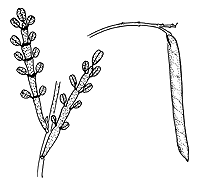Common name: Tick Indigo
Indigofera adesmiifolia A.Gray APNI* Synonyms: Indigofera australis var. signata Benth. APNI*
Indigofera australis var. platypoda Benth. APNI*
Indigofera australis var. signata APNI*

Description: Shrub 0.5–2(–3) m high; hairs scattered, appressed.
Leaves up to 6.5 cm long; rachis flattened, 1–4 mm wide; leaflets usually 13–19(–25), obovate, obtuse or emarginate, 1.5–7 mm long, 1–2 mm wide, rarely wider (leaflets sometimes falling early to leave the bare rachis); stipules triangular, to c. 1 mm long.
Inflorescences 2–5.5(–7.5) cm long. Calyx clothed with dark brown hairs, teeth subequal, shorter than the tube. Standard rose pink.
Pod terete, 2–4 cm long, sparsely hairy; seeds several, endocarp spotted.
Distribution and occurrence: Widespread in woodland, especially on the ranges and Slopes. Grows on rocky places, mostly on volcanics but also recorded from limestone areas.
NSW subdivisions: NT, CT, ST, NWS, CWS, SWS, NWP
Other Australian states: Qld Vic.
Intergrades with I. australis have been recorded from the few sites where these species co-occur. At these sites, a range of intermediate forms have been found.
Text by Peter G. Wilson
Taxon concept: Flora of NSW 2 (1991) but updated by Peter Wilson, October 2019
APNI* Provides a link to the Australian Plant Name Index (hosted by the Australian National Botanic Gardens) for comprehensive bibliographic data
***The AVH map option provides a detailed interactive Australia wide distribution map drawn from collections held by all major Australian herbaria participating in the Australian Virtual Herbarium project.
|


